ISSN 2410-5708 / e-ISSN 2313-7215
Year 11 | No. 31 | June - September 2022
© Copyright (2022). National Autonomous University of Nicaragua, Managua.
This document is under a Creative Commons
Attribution-NonCommercial-NoDerivs 4.0 International licence.
Inhibitory activity of leaf and bark extracts of the Tree Tetragastris panamensis (Engl.) Kuntze, on in vitro growth of Moniliopthora roreri (cif) H.C.Evans, Stalpers, Samson & Benny. (1978), Biology Laboratory, UNAN- MANAGUA, 2021
https://doi.org/10.5377/rtu.v11i31.14228
Submitted on January 17, 2022 / Accepted on April 19, 2022
Jubram José Gómez Murillo
National Autonomous University of Nicaragua, Managua
Faculty of Science and Engineering, Biology
https://orcid.org/0000-0002-9081-5152
Kennett Antonio Reyes Mejía
National Autonomous University of Nicaragua, Managua
Faculty of Science and Engineering, Biology
https://orcid.org/0000-0002-0223-2054
Noel Efraín Mercado Gaitán
National Autonomous University of Nicaragua, Managua
Faculty of Science and Engineering, Biology
https://orcid.org/0000-0003-1527-4779
Indira Sofia Guevara López
National Autonomous University of Nicaragua, Managua
Faculty of Science and Engineering
https://orcid.org/0000-0001-5279-9123
Juan Carlos Ruíz Urbina
National Autonomous University of Nicaragua, Managua
Faculty of Science and Engineering
Section: Sciences
Scientific Articles
Keywords: Inhibitory activity, fungicidal action, minimum inhibitory concentration.
Abstract
This research1 was carried out to evaluate the inhibitory activity of the extracts at different concentrations of bark and leaf of Tetragastris panamensis (Engl.) Kuntze on in vitro growth of Moniliopthora roreri (cif) H.C. Evans, Stalpers, Samson & Benny. ( 1978). The experiment consisted of three phases: first, the Soxhlet method was used to extract the oils by matrices and estimate their efficiency, then, a fungal susceptibility analysis was carried out where the method used was that of diffusion in agar Kirby-Bauer modifying it for the phytopathogen, finally, the minimum inhibitory concentration of the extracts of both matrices was determined using the serial dilution method, for all these processes, the variables temperature, time and exposure to light were controlled. The result was analyzed from the application of mixed methods integrating both quantitative and qualitative approaches which allowed us to verify that both matrices have fungicidal action. However, bark oil has greater fungicidal activity compared to phytopathogen.
Introduction.
According to Oporta (2020), cocoa (Theobroma cacao, L) is one of the items of high agro-ecological potential in Nicaragua and has a development of 1,853,968.00 hectares of land of which it is estimated 18,314.4 ha are under cultivation with a production of 16,551.7 tons in the hands of 13,000 small and medium farmers organized in 62% with cooperatives concentrated in the Autonomous Regions of the Caribbean and southern Coast, and in the departments of Matagalpa, Jinotega, and Rio San Juan, however, Obando (2015), points out that cocoa production is severely affected by the fungus Moniliophthora roreri (cif) H.C.Evans, Stalpers, Samson & Benny. ( 1978) that can reduce production by up to 80 or 90%, this phytopathogen damages the fruits, and its control is mainly cultural.
On the other hand, Querol (1996) states that the bark of the tree Tetragastris panamensis (Engl.) Kuntze has been used empirically by residents of the department of Rio San Juan, specifically in “El Castillo” municipality to fight athlete’s foot. Therefore, it is necessary to evaluate the inhibitory activity of the bark and leaf extracts of Tetragastris panamensis (Engl.) Kuntze on in vitro growth of Moniliopthora roreri (cif) H.C.Evans, Stalpers, Samson & Benny. ( 1978).
Likewise, this research was carried out in the Biology laboratory of the UNAN-MANAGUA in conjunction with the Center for Research on Aquatic Resources CIRA (as in Spanish). To this end, different methods were applied; the extraction of essential oils from leaf and bark was performed through the Soxhlet method, and the Kirby-Bauer agar diffusion method was used to check its fungicidal activity against Moniliopthora roreri (cif) H.C.Evans, Stalpers, Samson & Benny. ( 1978) indifferent concentrations, in addition, the minimum inhibitory concentration of each extract of the matrices was determined using the serial dilution method.
Materials and Methods
The research is experimental because variables such as temperature, time, and exposure to light were handled. It is a cross-sectional cohort because the data obtained in a single determined time were taken in the representative samples.
In addition, methods such as Soxhlet extraction, Kirby Bauer agar diffusion, and serial dilution were used.
Leaf and bark samples processing of Tetragastris panamensis (Engl.) Kuntze.
For the extraction of oil, the collection of samples with a total of 5 kg of leaf and bark was carried out, disinfected with 1% sodium hypochlorite, and left to dry for 15 days with indirect exposure to the sun. After the drying time, it is sprayed and packed in thermal bags.
Oil Extraction Method by the Soxhlet Method
In the solid-liquid separation technique, 96% ethyl alcohol was taken as a solvent and handled at 78°C because this is the optimal temperature for its boiling point.
The glassware used was washed and sterilized and 10 gr of the sample was weighed for each matrix in the Soxhlet equipment for a total of 100 gr per matrix the extraction was carried out for 6 hours, then the equipment was dismantled and evaporated at 78 °C in a water bath and stored in amber jars.
Kirby–Bauer method or disk diffusion
To evaluate the inhibitory activity of the extracts, the modified method of Diffusion in Kirby-Bauer Agar was applied.
1. The culture medium used was potato dextrose agar (PDA).
2. The Petri dishes were inoculated by scratching the surface of the culture medium in three directions with bacteriological handles that had been introduced into a previously prepared inoculum with a standardized scale.
3. The Petri dishes were incubated in an inverted position at 25° C for a period of 96 hours.
4. After the incubation time, the areas of inhibition produced by the extracts were measured in each petri dish.
5. The susceptibility reading was performed by observation and measurement of the inhibition halo around each sensidisc, this test was performed with 10 repetitions for each concentration of the extracts, each inhibition diameter was measured by categorizing the values as null, sensitive, very sensitive, and extremely sensitive with reference data by Duraffourd Lapraz cited by Soto and Ramírez (2018).
Serial dilution technique for the determination of the Minimum Inhibitory Concentration (CIM).
In the method of serial dilutions, peptone water was used to dilute the extracts, the inoculum was prepared to start from a pure culture of the phytopathogen with a standardized scale. Then serial dilutions of 5, 3, 2, and 1% were prepared, establishing ten repetitions for each concentration. Once the inoculation was carried out, it was incubated for 24 hours and the reading was made through the turbidity visible in test tubes in aid of the study carried out by (Díaz-Granados and Chaparro-Giraldo, 2011).
Results and Discussion
Oil efficiency per matrix of bark and leaf of Tetragastris panamensis (Engl.) Kuntze.
The oil output was evaluated based on the method used by Caldas Avila (2012), who used a gravimetric equation method that defines the method as the separation of a component of a mixture in the middle of a solvent, also details the efficiency as the amount of product (mL) obtained about the amount of sample used (in grams).
The matrices were evaluated by the percentage of solvent recovery and the percentage of output per matrix of which a total of 100 grams were processed and 1700 mL of solvent (96% ethanol) were used, which allowed the extraction of the essential oils of Tetragastris panamensis (Engl.) Kuntze, by the Soxhlet method. The data shown below compare the performance of oil extraction and solvent recovery percentages.
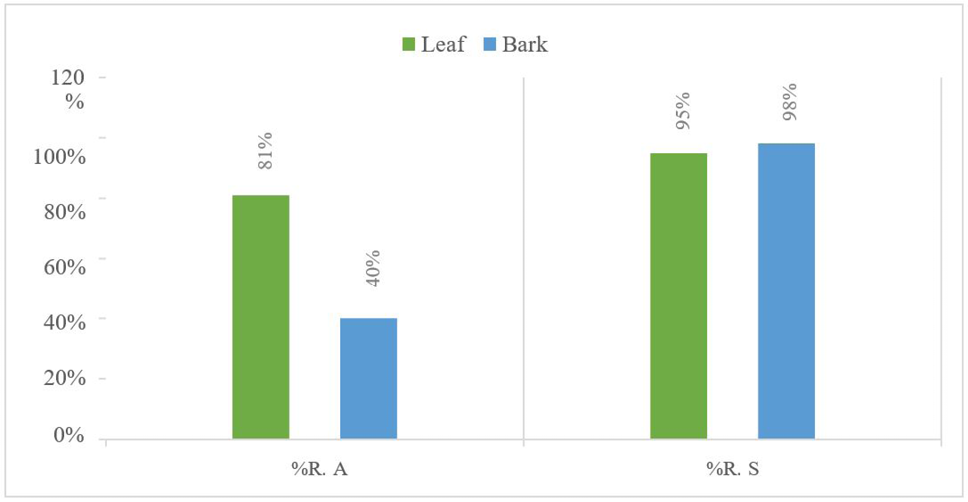
Graph N°1
Comparison of solvent recovery, extract obtained and efficiency by a matrix of Tetragastris panamensis (Engl.) Kuntze.
Source: https://orcid.org/0000-0002-9081-5152 /https://orcid.org/0000-0002-0223-2054 /https://orcid.org/0000-0003-1527-4779
When comparing the matrices using the same amount of sample and solvent it is highlighted that the leaf extract is more efficient in terms of oil efficiency (%R.A) with a percentage of 81% over 40% of bark, however, bark shows better results in the recovery of solvent (%R.S) because it presents a percentage of 98% on 95% of leaf, noting that in the extraction process the bark matrix presented greater volatilization of the solvent.
Susceptibility of Moniliopthora roreri (cif) H.C.Evans, Stalpers, Samson & Benny. (1978) versus extracts of Tetragastris panamensis (Engl.) Kuntze.
To start this method it became necessary to isolate Moniliopthora roreri (cif) H.C.Evans, Stalpers, Samson & Benny. (1978), which was carried out from infected cocoa fruits, which were inoculated in an aseptic medium in Petri dishes that were left in incubation for 10 days.
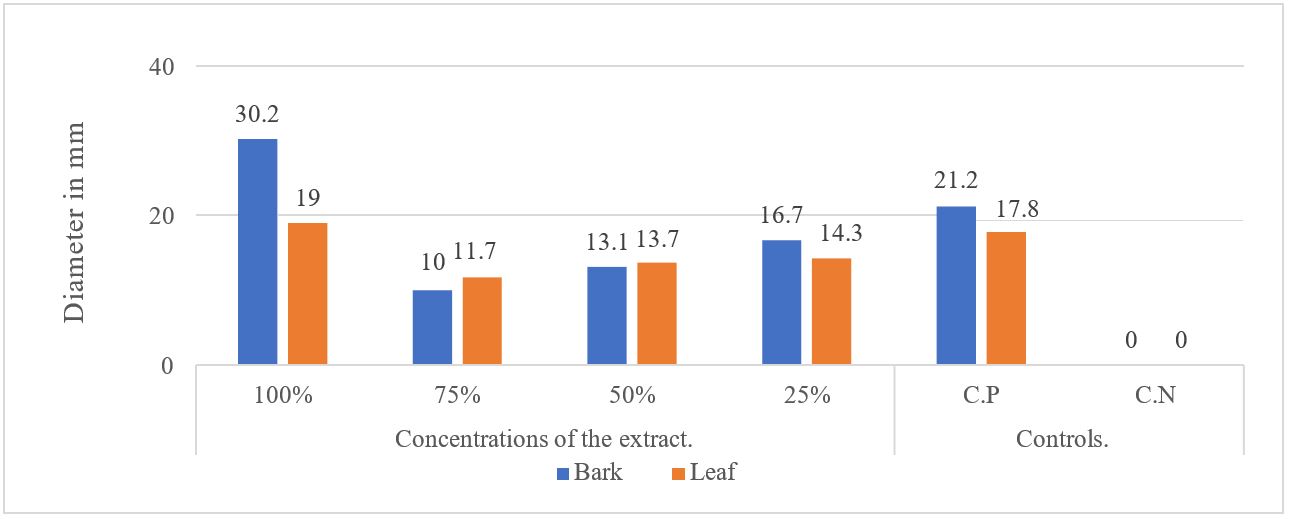
Graph N°2
Comparison of the average diameter of halos in both extracts concerning the concentrations evaluated.
Source: https://orcid.org/0000-0002-9081-5152 /https://orcid.org/0000-0002-0223-2054 /https://orcid.org/0000-0003-1527-4779
This graph shows the comparison between the average inhibitory halos of the different matrices used with each of their concentrations evaluated and based on the guidelines of the Duraffourd scale, and it can be observed that the concentration of the extracts shows the greatest effect against the pathogen Moniliopthora roreri (cif) H.C.Evans, Stalpers, Samson & Benny (1978) is the 100% concentration of bark extract with a diametrical average of 30.2 mm with category of highly sensitive over 19 mm of the 100% concentration of leaf extract categorized as very sensitive. However, it should be noted that both extracts fulfill a notorious inhibitory action against the aforementioned pathogen.
It should be noted that the concentrations at 75%, 50%, and 25% of both extracts also presented fungicidal action against Moniliopthora roreri (cif) H.C.Evans, Stalpers, Samson & Benny. (1978) categorized as sensitive and very sensitive, this is because the average inhibitory halo is 10 mm for bark and 11.7 for leaf in the concentration of 75%, then in the concentration of 50% there is a diameter of 13.1 mm for bark and 13.7 for leaf, these results are categorized as sensitive. Finally, the concentration at 25% presents inhibitory halos of 14.3 in the leaf and 16.7 in the bark matrix, it should be noted that the concentration at 25% of the bark matrix due to its diameter of 16.7 is categorized as very sensitive.
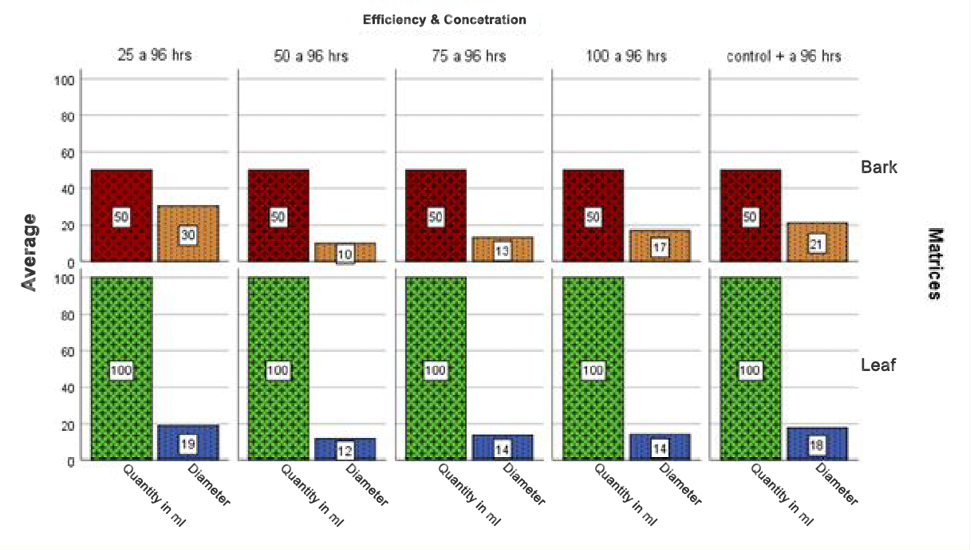
Graph N°3
Comparison of efficiency and fungicidal action of bark and leaf extracts of Tetragastris panamensis (Engl.) Kuntze. Against the phytopathogen Moniliopthora roreri (cif) H.C.Evans,Stalpers,Samson & Benny.( 1978).
Source: https://orcid.org/0000-0002-9081-5152 /https://orcid.org/0000-0002-0223-2054 /https://orcid.org/0000-0003-1527-4779. SPSS Program
In graph N°3, the comparison of the average of inhibition halos according to the evaluated concentrations and efficiency obtained by each matrix to visualize which extract shows more efficiency in terms of inhibitory action & performance. The bark matrix can be interpreted as less efficient; however, greater fungicidal activity is shown in the bark extract compared to the inhibition halos of the leaf extract.
Both extracts are efficient in terms of fungicidal activity in the different concentrations evaluated.
Distribution of efficiency by matrices.
In this statistical analysis, the leaf and bark matrices are contrasted, evaluating the efficiency, in this case, it was not possible to identify normality in the data, a non-parametric Mann-Whitney U statistic was applied to establish the following assumption:
Assumption 1: for the two matrices, the identical distribution.
Assumption 2: For the two matrices the distribution is not identical.
Table N°1
Distribution of efficiency.
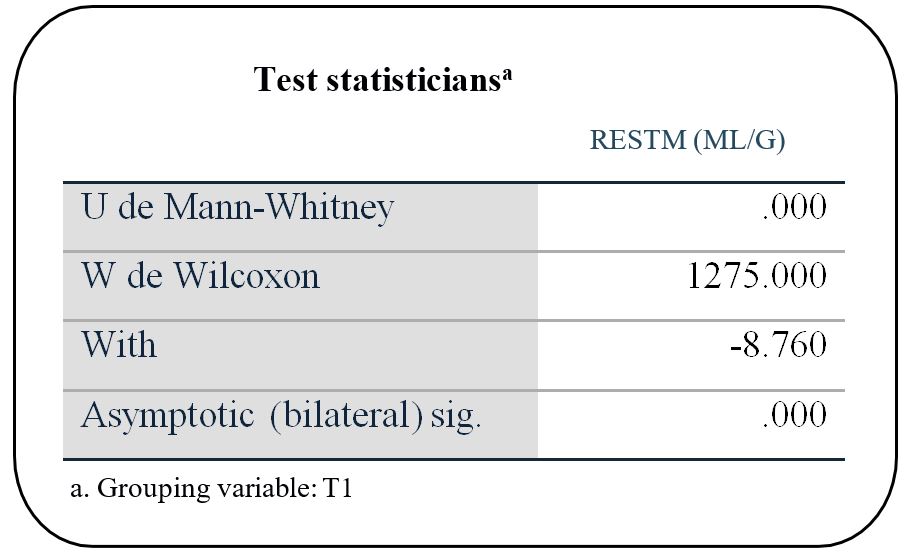
The probability associated with the test statistic obtained a value less than 0.05 this shows that the data do not have an identical distribution, in other words, the performance values are significantly different accepting assumption 2 of the distribution of efficiency by matrices.
Statistical analysis of the concentration of leaf extracts
Based on the non-parametric statistic. Kruskal-Wallis test, since the data do not show a normal distribution, we work with a level of significance α = 0.05, considering the following assumptions:
Assumption 1: The data is distributed significantly equally.
Assumption 2: Data is distributed differently.
Table N°2
Concentration analysis Vs diameter of the leaf extract.

Where the treatment variable is the concentration and the response variable is the diameter, an associated probability of Kruskal-Wallis statistics = 0.5408 was revealed, this makes known the non-rejection of assumption 1, therefore, it is concluded that the distributions for the 4 concentrations are significantly equal, all concentrations are statistically effective on the pathogen without there being a better concentration than another.
Statistical analysis of the concentration of bark extract.
Based on the non-parametric statistic: the Kruskal-Wallis test, because the data do not show a normal distribution, we work with an alpha significance level equal to 0.05, this test raises the following assumptions:
Assumption 1: The data is distributed significantly the same
Assumption 2: The data is distributed differently.
Table N°3
Analysis of concentration Vs diameter of the bark extract.

Where the treatment variable is the concentration and the variable response diameter, it should be noted that this analysis is only for bark concentrations; where an associated probability of Kruskal-Wallis statistics 0.0073 was revealed, this makes known the rejection of assumption 1, therefore, it is concluded that the distribution for the 4 concentrations at least 1 is different.
Table N°4
Analysis of the distribution of bark concentrations.

For this reason, this table was elaborated, with the InfoStat program, where three types of groups A, AB, B, in group AB (control +), one in group B, were identified, and when interpreted: the concentration that differs from the others with a greater diameter is the concentration at 100 belonging to group B, likewise, it is interpreted that the concentrations of 75, 50,
25 do not have a significant difference between them, for that reason, it does not matter what concentration is used, they do not generate a significant difference.
Statistical analysis for both extracts, leaf, and bark.
non-parametric based on the Kruskal-Wallis statistic. Taking into account the following assumptions:
Assumption 1: The data has the same distribution.
Assumptions 1: The data does not have the same distribution.
Table N°5
Concentration analysis Vs diameter of the leaf and bark extract.

The associated probability of the Kruskal Wallis statistic gives a value of 0.0096 and this is less than 0.05 therefore the assumption 1 is rejected, and it is concluded that the distribution between the data is different or the medians differ from each other, this may mean that there is a significant causal factor in the response of the diameters, that is, the behavior of these is not the same, for this purpose a posthoc test was elaborated in the InfoStat program where a comparison of concentration pairs is made that managed to identify that they are grouped in the same way.
Minimum inhibitory concentration (MIC) of the extract on Moniliopthora roreri (cif) H.C. Evans, Stalpers, Samson & Benny (1978).
This method was performed from a pure culture which was used to prepare the inoculum, then transferred to test tubes with different concentrations of the extracts (5%, 3%, 2%, and 1%), these concentrations were made from test tubes containing peptone water establishing ten repetitions for each matrix concentration of the extracts, being a total of forty tubes per matrix.
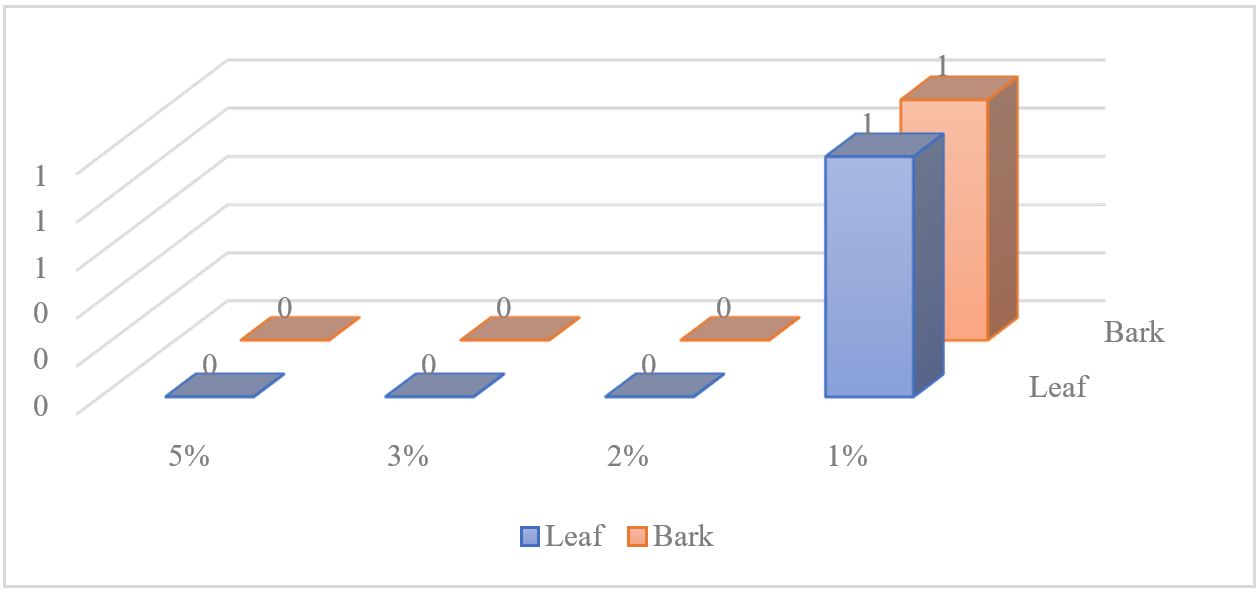
Graph N°4
Determination of the minimum inhibitory concentration in both extracts.
Source: https://orcid.org/0000-0002-9081-5152 /https://orcid.org/0000-0002-0223-2054 /https://orcid.org/0000-0003-1527-4779
The data expressed in Figure N°4 show the minimum inhibitory concentration of the four concentrations of leaf and bark extracts. These were measured through visible turbidity in test tubes.
The results obtained reflected that the concentrations of 5%, 3%, and 2% in each matrix are positive, however, the turbidity was visualized in the concentration at 1% of each matrix being this the minimum inhibitory concentration of the leaf and bark extracts of Tetragastris panamensis (Engl.) Kuntze is required to inhibit the growth of the studied phytopathogen.
Through the above results, it can be inferred that the phytopathogen is highly susceptible to the extracts under study, where the inoculum of this strain was inhibited in the concentrations of 5, 3 and 2 percent of the extracts validating the fungicidal action presented in the testing by the agar diffusion method explained above.
The extracts showed inhibitory action based on the turbidity of the test tubes, consequently, the leaf and bark extracts do not differ in terms of the minimum inhibitory concentration of both, since these showed their inhibitory effect at concentrations greater than 1%.
Conclusions
In short, it is estimated that the efficiency of essential oil of bark and leaf of Tetragastris panamensis (Engl.) Kuntze using the soxhlet method. shows better results in the leaf matrix having a more efficient performance, 81% for the leaf matrix and 40% for the bark matrix, therefore, containing more essential oil than the leaf matrix. To finish the statistical analysis, the non-parametric test U of Mann – Whitney was used where a value of significantly less than 0.05 was obtained, this shows that the data do not have an identical distribution, that is, that the performance values are significantly different validating that the best result is the leaf matrix.
The fungal susceptibility of tetragastris panamensis (Engl.) plant extracts was tested. Kuntze on the phytopathogen Moniliopthora roreri (cif) H.C.Evans, Stalpers, Samson & Benny. ( 1978) through the Kirby-Bauer method by diffusion in agar, showed expected results confirming that both matrices show fungicidal activity with the potential to inhibit the in vitro growth of phytopathogen. For the statistical analysis a non-parametric test was used, the Kruskal-Wallis test, in both matrices where: leaf gives us a level of significance of 0.541, which verifies that the concentrations are statistically effective on the phytopathogen, without there being a concentration better than another, as for the bark matrix, the results show 0.007, it is concluded that the distribution for the 4 concentrations at least 1 is different, therefore, a median Ranks test was used within the InfoStat program where it was possible to identify three groups for our concentrations A, 75,50,25. AB positive control. B.100 where it was possible to identify that concentration 100 is different from the others presents better results statistically.
It was verified that the minimum inhibitory concentration (MIC) of plant extracts on Moniliopthora roreri (cif) H.C. Evans, Stalpers, Samson & Benny. (1978) was determined by serial dilutions of: (5%, 3%, 2%, and 1%), with the concentration at 1% being the minimum inhibition concentration of both extracts, which shows that both matrices contain a high fungicidal activity to inhibit the growth of phytopathogen in vitro.
Footnotes
1. Article derived from monographic thesis entitled: Inhibitory activity of leaf extracts and bark of the tree Tetragastris panamensis (Engl.) Kuntze, on in vitro growth of Moniliopthora roreri (cif) H.C.Evans, Stalpers, Samson & Benny. (1978), Biology laboratory, UNAN-MANAGUA, 2021. In the period from January to October 2021.
Bibliography
Caldas Avila, A. P. (2012). Optimización, escalamiento y diseño de una planta piloto de extracción sólido líquido. Cuenca: Universidad de Cuenca.
Ceballos, M. A. (2012). ANÁLISIS DE PARÁMETROS MICROBIOLÓGICOS. Guatemala.
Diaz-Granados, C. D., & Chaparro-Giraldo, A. (2011). Concentración mínima inhibitoria de Kanamicina para callos de cuatro variedades colombianas de arroz. Revista Colombiana de Biotecnologia, 11.
Obando, M. (2015). Producción moderna del cacao (Theobroma cacao). Managua: INTA.
Oporta, E. (10 de Mayo de 2020). Produccion de Cacao 2020. Managua: El 19 digital.
Querol, D. (1996). Especies utiles de un bosque humedo tropical. Lima: INDUSTRIALgrafica S.A.
Piura López, J. (2008). Metodología de la investigación cientifíca- Un enfoque integrador. Managua: 6ta ed.- Managua: Xerox.
Soto Macetas, R., & Ramirez Heredia, R. (2018). "Efecto antibacteriano del aceite de las hojas de Molle (Schinus Molle. L) frente a cepas de Escherichia Coli" in vitr. Lima. Lima.
Arango, N. A., Vanegas, N. B., García, C. M., & Rojano, B. (1 de Mayo de 2007). actividad antifungica del isoespintanol sobre hongos del genero colletotricum. medellin., Medellin, Colombia.
Barrera, F. O., & Espinoza, P. C. (2002). Marcha fitoquímica y actividad citotóxica con Artemia Salina de la corteza del arbol Tetragastris panamensis (Kerosin). Nicaragua.: UNAN-LEON.
Gómez, M. O. (.). Metodología de la Investigación. Universidad Hispanoamericana: Campus San Jerónimo.
Jaramillo, B. E., Duarte, E., y Delgado, W. (2012). Bioactividad del aceite esencial de Chenopodium ambrosioides colombiano. Revista Cubana de Plantas Medicinales, 17.
María José Usaquén Ramírez, m. a. (2018). evaluación del proceso de obtención de aceite esencial a nivel laboratorio. bogotá.
Mondino, D. P. (2012). Métodos de aislamiento. Unidad de Fitopatología.